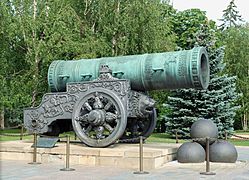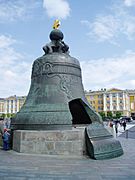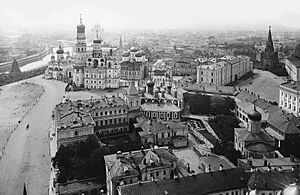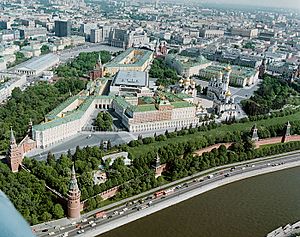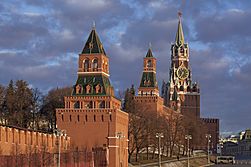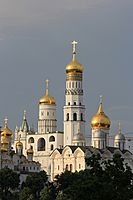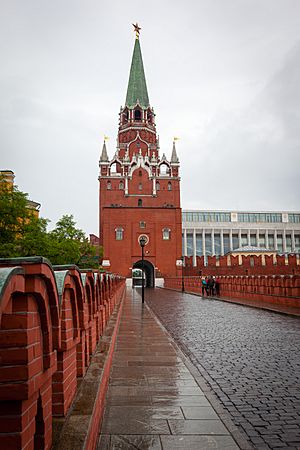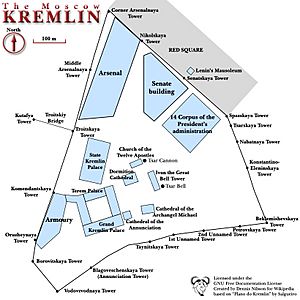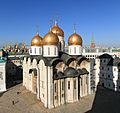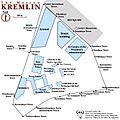Moscow Kremlin facts for kids
Quick facts for kids Moscow Kremlin |
|
|---|---|
| Native name Russian: Московский Кремль |
|
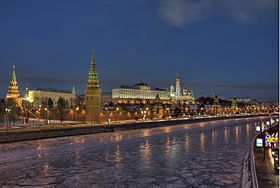 |
|
| Location | Moscow, Russia |
| Area | 27.7 ha (0.277 km2) |
| Built | 1482–1495 |
| Official name: Kremlin and Red Square, Moscow | |
| Type | Cultural |
| Criteria | i, ii, iv, vi |
| Designated | 1990 (14th session) |
| Reference no. | 545 |
| Region | Eastern Europe |
| Lua error in Module:Location_map at line 420: attempt to index field 'wikibase' (a nil value). | |
The Moscow Kremlin (Russian: Московский Кремль, tr. Moskovskiy Kreml', IPA: [ˈmɐˈskofskʲɪj krʲemlʲ]), often called just the Kremlin, is a strong fortress in the center of Moscow. It was built by the Rurik family, who were early rulers of Russia. It is the most famous of all the Russian fortresses, known as kremlins.
Inside its walls, you'll find five palaces, four cathedrals, and many towers. The Grand Kremlin Palace used to be where the Russian kings, called Tsars, lived in Moscow. Today, the Kremlin is the official home of the President of Russia. It's also a popular museum, with almost 3 million visitors in 2017.
The Kremlin sits by the Moskva River to the south. To the east, you can see Saint Basil's Cathedral and Red Square. The Alexander Garden is to the west.
The word "Kremlin" means "fortress inside a city." People often use "the Kremlin" to mean the Russian government. In the past, it referred to the government of the Soviet Union (1922–1991). The study of Russian politics is even called "Kremlinology"!
The Kremlin is open to visitors. You can take tours and see amazing things like the Armoury Chamber, the huge Tsar Cannon, and the giant Tsar Bell.
Contents
History of the Moscow Kremlin
Early Beginnings
People have lived on this spot since the 2nd century BC. Around the 11th century, early Slavic people settled on Borovitsky Hill. This was where the Neglinnaya River met the Moskva River. They built a fortified village, or "grad," here.
Until the 14th century, this place was simply called the 'grad of Moscow'. The word "Kremlin" was first written down in 1331. Prince Yuri Dolgorukiy made the grad much bigger in 1156. It was destroyed by the Mongols in 1237 but rebuilt with oak wood in 1339.
Home of the Grand Dukes
Dmitri Donskoi made the Kremlin much stronger between 1366 and 1368. He replaced the old oak walls with new ones made of strong white limestone. These walls were so strong that they helped Moscow survive an attack by Khan Tokhtamysh.
Dmitri's son, Vasily I, continued building churches and monasteries inside the Kremlin. The Cathedral of the Annunciation was painted by famous artists like Theophanes the Greek and Andrei Rublev in 1406.
Palace of the Tsars
Grand Prince Ivan III decided to rebuild the Kremlin in a big way. He invited skilled architects from Italy to help. Petrus Antonius Solarius designed the new Kremlin wall and its towers. Marcus Ruffus designed a new palace for the prince.
During Ivan III's rule, three important cathedrals, the Deposition Church, and the Palace of Facets were built. The tallest building in Moscow at the time was the Ivan the Great Bell Tower. It was built between 1505 and 1508 and made even taller in 1600. The Kremlin walls you see today were built from 1485 to 1495.
After the new walls and churches were finished, the ruler said no new buildings could be built right next to the fortress. A wide moat separated the Kremlin from the merchant town. Saint Basil's Cathedral was built over this moat during the time of Ivan the Terrible.
During a difficult time in Russian history called the Time of Troubles, Polish forces held the Kremlin for two years (1610-1612). A volunteer army led by Prince Dmitry Pozharsky and Kuzma Minin freed the Kremlin. This led to Mikhail Romanov becoming the new Tsar.
Later, under Tsars Mikhail, Alexis, and Feodor, many new buildings were added. These included the Upper Saviour Cathedral, the Terem Palace, and the Amusement Palace.
Tsar Peter did not like the Kremlin after a rebellion in 1682. Thirty years later, he moved the capital to his new city, Saint Petersburg.
The Imperial Era
Even though the capital moved, the Kremlin was still used for important events like coronations. But it was often neglected. In 1773, Catherine the Great wanted a new residence built there. Her architect, Vasili Bazhenov, designed a huge palace. This plan would have meant tearing down many old churches and parts of the Kremlin wall. However, the project was too expensive and never finished.
Years later, architect Matvey Kazakov rebuilt the parts of the wall that had been taken down. He also built the large and grand Offices of the Senate. Today, this building is where the President of Russia works.
From the early 1700s to the late 1800s, the Kremlin walls were usually painted white.
French forces led by Napoleon occupied the Kremlin in 1812. When Napoleon left Moscow, he ordered the entire Kremlin to be blown up. The Kremlin Arsenal, parts of the wall, and some towers were destroyed by explosions. Other buildings were damaged by fire. Luckily, rain damaged some of the fuses, so the damage was not as bad as planned. The Kremlin was repaired between 1816 and 1819.

When Tsar Nicholas I visited Moscow for his coronation, he didn't like the old Grand Palace. So, he ordered a new one to be built. The architect Konstantin Thon designed the Grand Kremlin Palace. It was built from 1839 to 1849 and was meant to be as grand as the Winter Palace in St. Petersburg. The Kremlin Armoury was also rebuilt in 1851.
After 1851, the Kremlin didn't change much until the Russian Revolution in 1917.
The Soviet Era and Today
The Soviet government moved to Moscow in 1918. Vladimir Lenin chose the Kremlin Senate as his home. Later, Joseph Stalin also lived there. Stalin wanted to remove anything that reminded people of the old Tsarist rule. The golden eagles on the towers were replaced with shining Kremlin stars. The wall near Lenin's Mausoleum became a special burial place called the Kremlin Wall Necropolis.
Sadly, some historic buildings like the Chudov Monastery and Ascension Convent were torn down to make space for a military school.
During World War II, the Kremlin was camouflaged to confuse German pilots. The towers were painted different colors, and roofs were painted rusty brown. The cobblestone ground was covered with sand. Tents painted like roofs were stretched over gardens, and buildings were painted to blend in.
The Kremlin was closed to tourists until 1955. It was reopened to visitors during a time of change called the Khrushchev Thaw. The Kremlin Museums were created in 1961. In 1990, the Kremlin became one of the first Soviet sites to be added to the World Heritage List.
Today, efforts are made to restore the Kremlin's original beauty. The Grand Kremlin Palace has had expensive renovations to bring back its old look.
State Kremlin Palace
The State Kremlin Palace (also called the Kremlin Palace of Congresses) was built inside the Kremlin walls from 1959 to 1961. Nikita Khrushchev ordered it built as a modern place for Communist Party meetings. It has white marble on the outside and tinted, reflective windows.
Building such a modern structure in a historic area caused some upset. It replaced several old buildings, including parts of the Great Kremlin Palace. Even though Soviet laws were supposed to protect old buildings by the 1950s, the Palace was still built. It is now connected to the larger Grand Kremlin Palace complex.
Buildings of the Kremlin
The Kremlin walls and towers we see today were built by Italian masters from 1485 to 1495. The Kremlin wall forms an uneven triangle and covers an area of 275,000 square metres (2,960,000 sq ft). Its total length is 2,235 metres (2,444 yards). The wall's height changes from 5 to 19 metres (16 to 62 ft), depending on the ground. It is between 3.5 and 6.5 metres (11 and 21 ft) thick.
There were originally 18 Kremlin towers. This number grew to 20 in the 17th century. Most of the towers are square. The tallest tower is the Troitskaya Tower, which is 80 metres (260 ft) tall. It was built to this height in 1495. Many towers originally had wooden tops. The brick tops with colored tiles you see now were added in the 1680s.
Cathedral Square is the very center of the Kremlin. Six buildings surround it, including three important cathedrals. The Cathedral of the Dormition was finished in 1479. It was the main church of Moscow where all the Tsars were crowned. Its large limestone front has five golden cupolas. Many important religious leaders are buried here.
Next, the gilded, three-domed Cathedral of the Annunciation was finished in 1489. It was later rebuilt with nine domes. To the southeast of the square is the much larger Cathedral of the Archangel Michael (1508). Almost all the early Moscow rulers are buried here.
There are also two smaller churches for the Metropolitans and Patriarchs of Moscow. These are the Church of the Twelve Apostles (1653–1656) and the beautiful Church of the Deposition of the Virgin's Robe. The latter was built by Pskov artists from 1484 to 1488. It has amazing icons and paintings from the 1600s.
Another famous building is the Ivan the Great Bell Tower on the northeast side of the square. People say it marks the exact center of Moscow. It looks like a burning candle. Finished in 1600, it is 81 metres (266 feet) high. Before the Russian Revolution, it was the tallest building in the city. No other building was allowed to be taller. Its 21 bells would ring if an enemy was coming. The top part was destroyed by the French during Napoleon's invasion but was rebuilt. The Tsar bell, the biggest bell in the world, stands on a platform next to the tower.
The oldest non-religious building still standing is Ivan III's Palace of Facets (1491). This is where the royal thrones were kept. The next oldest is the first home of the royal family, the Terem Palace. Most of the current Terem Palace was built in the 17th century.
The Terem Palace and the Palace of Facets are connected by the Grand Kremlin Palace. Nicholas I ordered this palace built in 1838. It is the largest building in the Kremlin. It cost a lot of money to build and even more to renovate in the 1990s. It has dazzling reception halls, a grand red staircase, and the private rooms of the Tsars. It also includes the lower part of the Resurrection of Lazarus church (1393), which is the oldest building still standing in the Kremlin and all of Moscow.
The northern part of the Kremlin has the Arsenal. This building was made for Peter the Great in 1701. The southwestern part of the Kremlin holds the Armoury building. Built in 1851, it is now a museum. It holds Russian royal treasures and the famous Diamond Fund.
Helipad
To help with traffic, Russian President Vladimir Putin approved building a helipad in the Kremlin. It was finished in May 2013. Now, the Russian President can travel to and from the Kremlin using a Mil Mi-8 helicopter. The location was chosen carefully to make sure it would not harm the Kremlin's historic buildings.
Getting to the Kremlin
The closest Moscow Metro stations to the Kremlin are: Okhotny Ryad, Biblioteka Imeni Lenina, Teatralnaya, Ploshchad Revolyutsii, Arbatskaya, Alexandrovsky Sad, and Borovitskaya.
Images for kids
See also
 In Spanish: Kremlin de Moscú para niños
In Spanish: Kremlin de Moscú para niños



